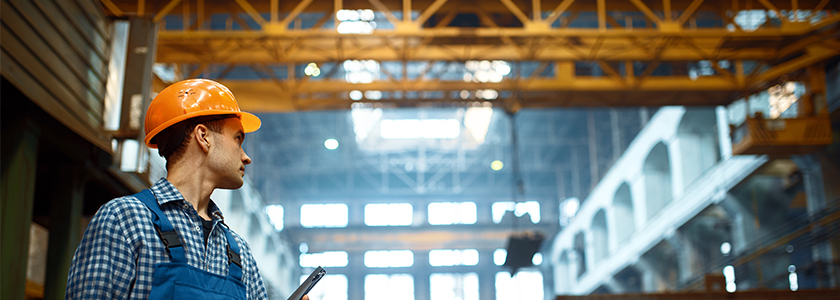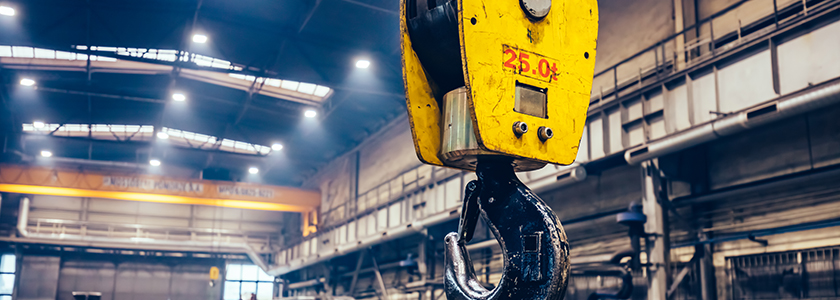What does the lifting height of a crane need to be? Deciding on the appropriate crane height for your warehouse or factory seems like it should be a simple task, but there may be more to it than you realise.
Sure, you need a crane capable of lifting and shifting loads from point A to point B, but you also need to work within a number of limitations, not least the dimensions of the building the crane will be installed within. There’s no such thing as an ‘average crane height’ – you’ll need to identify the height that’s right for you.
In this guide we’ll talk all things crane height: the measurements that matter, the factors to consider, and the ways you may be able to maximise the lift height of your crane when you’re working within a confined space.
The lifting height measurements you need to know
Before we work out the ideal height of our crane, we first need to understand exactly what we mean by ‘height’. Are we talking about the total size of the crane, from base to highest point? How high it can lift an item? The travel distance of the hook?
There are three main measurements that define a factory crane’s height: lift height, c-dimension and headroom.
Lift height
When people refer to the ‘lifting height of a crane’, they usually mean lift height, which is the distance from the floor to the hook (or more specifically, the hook’s saddle) when it is fully retracted, i.e. at its highest possible position. In many ways this is the most critical measurement, as it defines the size of the load that your crane can lift.
It should be noted that this dimension doesn’t account for lifting gear and other load-fixing equipment that may hang off the hook – a crane with a lift height of 4m wouldn’t be able to lift a 4m bar in the vertical position, as hook attachments would reduce the true lift height.
C-dimension
We’ll now work our way up from the hook saddle, measuring the distance from there to the point where the trolley wheels meet the running surface on which they roll. Referred to as the ‘c-dimension’, this tells you the size of the hook when in its uppermost position.
Headroom
If we move up again, we begin to concern ourselves with headroom. Your crane will obviously need to fit within your building, ideally comfortably. For column-mounted and wall-mounted cranes, this is a simple matter of ensuring the top of the jib arm won’t hit any obstructions, whether ceiling or walls.
For overhead/gantry cranes, headroom describes the available space between the top of the rail and the lowest ceiling obstruction. Ensuring there is enough headroom is far simpler if you’re installing a freestanding gantry crane than if you’re relying on a building’s pre-installed or pre-existing rails.
Factors to consider when determining crane height
Now that we have a basic understanding of the most important measurements, what other factors might impact crane height for those trying to determine it?
The loads you’ll need to lift
What is the largest load that you will need to lift? Along with ensuring the working load limit (WLL) is enough to cope with the weight, you’ll need to ensure that your chosen crane has enough lift height to comfortably pick up the largest item you’re likely to need to move.
Remember to include some wiggle room in your estimates to account for lifting gear and load fixing equipment, and remember that loads can be as cumbersome in the horizontal dimension as they are in the vertical, so you’ll need to ensure your crane has appropriate reach.
The type of crane
Different cranes are capable of lifting loads to different heights in a given space. Often this is down to headroom and c-dimension. Column-mounted jib cranes, for example, tend to feature a strut that, while strengthening the arm, adds to the total height of the crane, which reduces the available headroom, and therefore the lift height, when it is placed somewhere with limited vertical room.
Overhead cranes and monorail systems demand less headroom while offering more lift height, so are popular choices in factory and warehouse settings. There are even specially designed low headroom crane systems that are ideal for use in particularly pokey settings, but more about these solutions below.
The space you have to play with
Whichever crane you choose, and whatever lift height you believe you need, it will need to work within the space you have. Carefully measure the area in which you plan to install the crane, paying particular attention to obstructions that might hang from the ceiling or hang off the walls, and may affect your ability to install or operate your preferred lifting solution.
Ways to maximise factory crane lift height
Generally speaking, too much lift height is better than not enough. So how do you maximise the amount of lift height if you’re installing a crane within a pre-existing building?
Monorail systems
Monorail systems maximise gantry crane height by hanging a low profile rail from the ceiling for a hoist to roll along. These cranes are a popular choice in factory settings, and not just for their ability to maximise lift height; they can be built to follow a production line, sending items from the beginning of the process to the end without the need to unhook the load.
Low headroom cranes
Your factory or warehouse may need more lifting flexibility than a monorail system can offer – i.e. the ability to lift and shift loads anywhere within reach. Enter low headroom cranes, which offer a great lifting solution in confined spaces. These solutions come in a number of different forms, including low headroom jib cranes and gantry cranes.
Girder configuration
You may be able to maximise the lift height of an overhead gantry crane by tweaking the girder configuration. Choosing shorter girders, or connecting your girders to the end truck using a side connection rather than a top connection, can help the crane fit into the available headroom while maximising lift height.
Finally, you might consider a double-girder design. On a single girder crane the hoist can only run on the bottom of the girder. But on a double girder crane, the hoist can operate within the space between the two girders, allowing your hook to lift higher than the bottom of the girder, thereby increasing lift height.
Enabling New Zealand businesses to work smarter, quicker and safer
Crane lifting height is just one of a wealth of factors to consider when choosing a crane. Given cranes aren’t an everyday purchase, and every buyer has unique needs that are rarely met by an off-the-shelf product, identifying the right piece of lifting equipment can feel challenging, perhaps overwhelming.
That’s where we come in.
At Stratalign we’ve built a reputation for supplying Kiwi businesses with cranes that make their businesses work smarter, quicker and safer. We can help you understand the best crane for your situation, and find a crane that will fit within your factory while boosting safety, efficiency and productivity.
If you’re looking to enhance your operations with a piece of lifting equipment, get in touch with our expert team today for a no-obligation consultation and quote.




